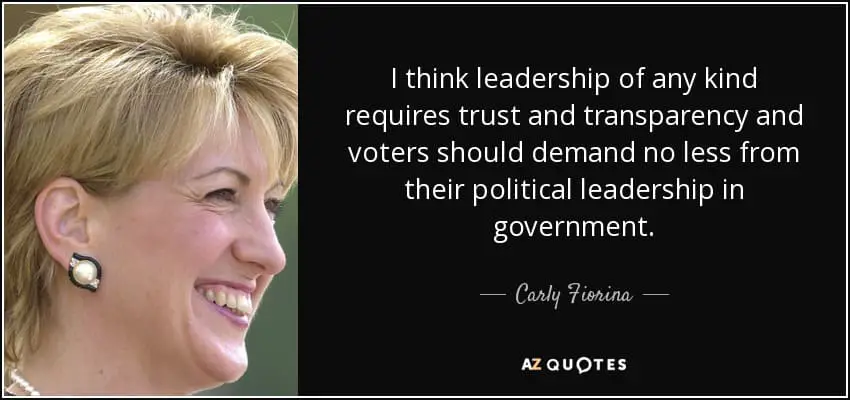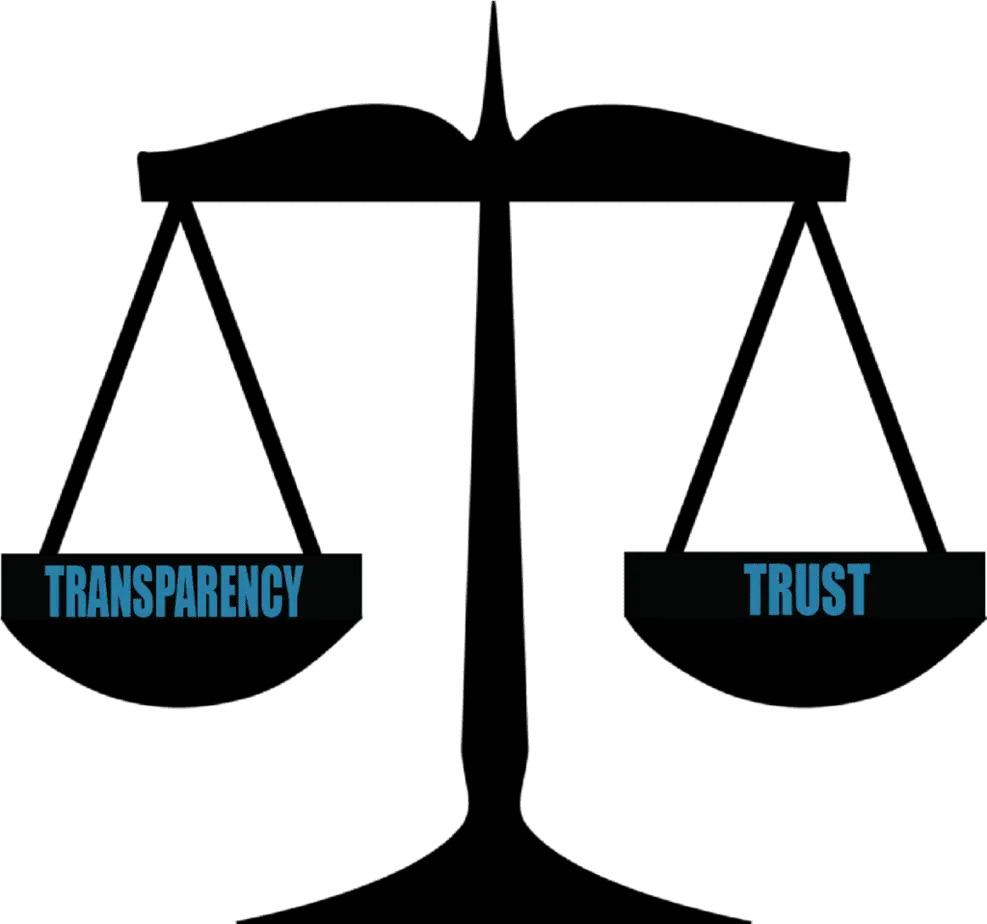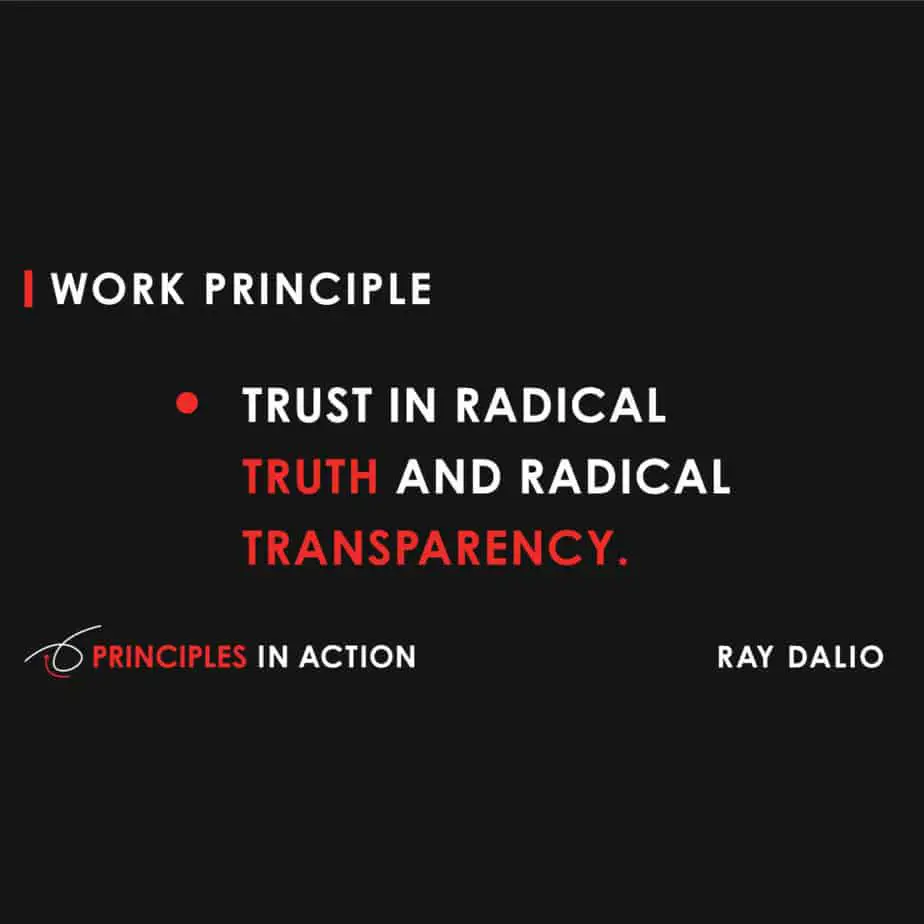“The most important role of a leader is to set a clear direction, be transparent about how to get there, and to stay the course.” – – Irene Rosenfeld, CEO at Mondelez International (currently worth over $80 Billion dollars as of September 2022)
Every good leader knows that it’s the employees that are at the heart of the company. With-out employees there would be no company.
According to a survey from the American Psychological Association, half of the workforce in the United States believes their employers are keeping things from them. Even those who feel like their bosses treat them fairly, don’t believe that their bosses are completely honest.
These feelings breed mistrust, lack of work-place enjoyment, and can hurt job performance.
If corporations want to combat feelings of distrust, it’s crucial to have management that leads with transparency. But what does it mean to lead with transparency? What does that look like and how do you do it?
In this article, we’ll look at expert opinions, perspectives, and the science behind why learning to lead with transparency is crucial long term success.
Let’s Dive In.
The Scientific Link Between Trust And Transparency
There’s a huge push right now to have more transparency in the workplace, in government, and institutions worldwide. The question is, does transparency build trust?

In a keynote speech in 2019, Dr. Harvey V. Fineberg, MD, PhD, (a former Dean at Harvard and retired President of the Institute of Medicine), presented the findings of a committee review who discovered that, from 1978 to 2018, the level of public confidence in the scientific community has been consistently higher than public confidence in other institutions, including major companies, the press, and in Congress.
So why is public trust in science so much higher than public trust in corporations and in Congress?
Dr. Fineberg believes that “data sharing and transparent reporting” is an expectation of the scientific community, two qualities that corporations, and government entities severely lack.
According to a study lead by Martín Alessandro (an independent government consultant and Professor at the University of Buenos Aires) and published by Science Direct, …
“Increasing transparency helps to improve trust in the government”.
These results of the study highlight the importance of actively disclosing information as a way to enhance transparency and built trust.
Transparency alone can’t create unbridled trust. But it is a major factor in building long term trust. To create trust, you’ll need a recipe of factors including, transparency, consistency, accountability, action, and results.
What Does It Mean To Be Transparent as a Leader?
If you want to be a transparent leader, there are a few things you’ll need to do.

1. Communicate Goals and Expectations
According to Front.com, a business dedicated to business growth through improved transparency, a commitment to workplace transparency means keeping people informed.
CEO of Front.com, Mathilde Collin, believes transparent leaders update their teammates on the progress of company-wide goals, areas where the team has fallen short, sets clear expectations, and actionable goals for their team moving forward (including themselves).
They know that by communicating these goals and expectations it will help empower others to take charge when need be, keep focused on ‘big-picture’ goals, and stay engaged in their work longer.
2. Explain Decisions
As put into perspective by Niagara Institute, transparent leaders talk with their team through their decision-making strategies. They earn their employee’s trust by explaining their decisions and hearing out their concerns.
This approach can help team members get on board or provide valuable feedback with any changes that need to be implemented to achieve team goals.
3. Consistency is Key
Transparent leaders understand how important and essential it is to treat all team members equally across the board. Including themselves.

They don’t play favorites (even for high performers), and they make sure to hold themselves accountable to the same standards as everyone else. ALWAYS.
4. Trust The Team
Transparent Leaders show their team that they can be trusted by treating them like the mature, capable individuals that they are. And they certainly don’t withhold information based-on-the-fear that the team will crumble under the weight of the information.
9 Benefits of Transparency in Leadership?
Let’s break down 14 of the top benefits to being a transparent leadership to gain a deeper understanding for the importance of transparency.

1. Attract High-Quality Applicants
Companies with a culture of transparency in your workplace create a ‘’buzz’’ that people outside the company will become aware of.
If your employees are happy, they’ll let people know. This positive buzz will attract better applicants for open positions. The best candidates know their worth and will only work for companies that value their time, effort, and provide a proven culture of transparent leaderhip.
2. Increased Employee Retention
It should come as no surprise that those who lead with transparency keep their employees for longer.
According to expert staffing agency GreenHouse Software Inc., Employees feel like they’re being “”left in the dark”” when they’re not told or included in important change decisions. When transparency is lacking employees feel undervalued and underappreciated.
That’s why, in the eyes of GreenHouse, “transparency is key”. When employees feel included in the decision-making process they naturally become more “”invested”” in the company’s wellbeing, mission, and core values.
And an employee who feels more invested and engrained with-in their team will stick around and contribute for a longer period of time.
3. Increased Collaboration
When you encourage open communication between employees, they’re more likely to put their heads together to develop innovative ideas to tackle the job.

According to UX matters (a company dedicated to improving user experiences in tech) “Greater transparency and communication lets organizations break down silos and work cross-functionally together, benefiting everyone involved.”
UX Matters researcher, Megan Wenzel, writes that collaboration can inspire a wider range of innovative ideas. They’ve found that by bringing different viewpoints, backgrounds, and expertise together to collaborate transparently, companies avoid blind spots and address issues that were not initially identified.
4. Improved Workplace Engagement
Encouraging transparent communication allows employees to work more efficiently and provides an environment where team members feel comfortable to experiment with innovative approaches to reaching team goals.
A transparent approach will keep people engaged in team projects for longer periods of time.
5. Faster Problem Solving
Creating a climate of transparency in the workplace will help your team come together to solve problems more quickly and efficiently.
David Poirier, CEO of management consulting company ‘’The Poirier Group Inc.’’, teaches his clients that…
“Transparency is the key to developing successful solutions for “unsolvable” problems”
Mr. Poirier says that “you cannot build a house without first constructing the foundation, and for businesses, a culture of transparency is the foundation needed to succeed.”
Dave continues on by saying that “Instead of rushing to solutions, first ensure that you have a strong culture of transparency, and implementing solutions to “unsolvable” problems will become much simpler.”
6. Creates Authentic Relationships
Transparent leaders treat their employees as equals.

They get to know their team members on a personal level and allow their team members to get to know them personally. This opens the lines of communication and helps build authentic relationships with team members over time.
Weak leaders pretend to be nice (fake nice), which causes sub-conscious feelings of uneasiness and distrust.
7. Enhanced Work Performance
By sharing information and keeping employees ‘’in the loop’’ it creates an atmosphere of increased employee certainty and employees will respond with increased trust and better focus.
In return, less time will be spent wondering “”what if”” and more time will be spent focusing on work problems with an increased motivation to work toward common goals.
8. Managed Expectations
Since transparent leadership focuses heavily on clarity and communication, team members working under transparent leaders will always know exactly what is expected from them.
They also know what they can expect from their leader, fellow team members, and the organization as a whole. Employees know what they need to do to get raises and promotions, as well as when and how they can schedule time off.
9. Increased Morale and Job Satisfaction
Employees thrive in a work environment that focuses on open communication and clarity. When they feel heard and informed and know what’s expected of them at all times, they are more likely to enjoy their jobs and feel happier at work.
Transparency leads to a greater feeling of inclusion which breeds higher levels of workplace happiness.
12 Ways To Be A More Transparent Leader
We’ve reviewed the importance and benefits of transparency in leadership; now, we’ll explore effective ways to implement a culture of transparency.

1. Be Open About Failures
Many leaders are happy to share their successes but often keep quiet when they fail.
When the goal is transparency, discussing failure is equally as important as sharing success stories. Transparent leaders who own failures, motivate employees by showing them that they’re committed to growing and improving along with the rest of the team.
Afterall, we’re all humans and acknowledging shortcomings builds trust and encourages groundedness.
2. Encourage Honest Feedback
Encourage all feedback, good and bad. Make sure your team members know they can voice their concerns and address them as diplomatically as possible.
This principle is exactly why we at the-Conscious-Vibe ask for critical feedback at the end of all of our articles.
3. Be Accessible
When leaders hide behind company policies or closed office doors, it breeds distrust.
If the goal is transparency, be available to talk to team members when they have questions or concerns. Transparent leaders want to ensure that everyone can access proper training resources and extra support when needed.
Ron Ricci is the CEO of a software company called the Transparency Imperative which focuses on measuring a company’s level of transparency with very specific data metrics.
According to Mr. Ricci, accessibility is defined by the “degree to which employees believe their manager doesn’t create barriers when it comes discussing decisions that affect them.”
Basically Ron is saying that it’s not just enough to be available. Transparent leaders MUST be willing to discuss decisions with their employees, especially decisions related to the company’s budget, people, and processes.
Don’t hide.
4. Get to Know Your Employees
There’s no ‘’sugarcoating’’ or shortcuts to take here. You have to actually care.

The cornerstone of transparency in the workplace is communication. If you get to know your team members personally and allow them to get to know you, you’ll open the door for open and honest communication.
According to business magnate and serial entrepreneur Gary Vee, “When you realize you work for your employees and not the other way around, things start to change :)”
Gary says that it’s clear that employee first businesses will win in the next decade. He goes on to explain that employee first businesses have won big for many years now which is the reason he surrounds himself with successful people who have empathy for others and understand this concept well.
Employees are more likely to trust leaders who show that they care about their well-being. Transparent leaders like Gary Vee show employees that they care by helping them find solutions for all types problems they may be facing.
Don’t offer unsolicited parenting advice or anything. As a quick example, suppose you know an employee is struggling to find adequate childcare, and there’s an opening at your child’s daycare. In that case, you could pass along the daycare’s contact information as a possible solution.
5. Encourage Experimentation
Transparent leaders encourage employee experimentation and give credit where it’s due.
Make sure each team member’s voice is heard and praise them for putting their ideas out there. Remember that each failure is ultimately a learning opportunity and that experimentation will lead to faster, more innovative ways to meet team goals.
6. Be Radically Honest
Radical honesty is telling the absolute truth at all times. Transparent leaders relay critical information to employees as soon as possible after receiving the information themselves.
In his book, Principles, Self-made billionaire Ray Dalio says that “Understanding what is true is essential for success, and being radically transparent about everything, including mistakes and weaknesses, helps create the understanding that leads to improvements.”

To eliminate gossip, all team members need to know what’s going on in their workplace, good or bad.
Radical honesty in leadership also means telling employees what you notice when you notice it. For example, talk to team members immediately instead of making mental notes of positive and negative behavior for the annual review.
Offering praise or constructive criticism in the moment will keep the office running more smoothly and help you gain your employees’ trust.
7. Be Vulnerable
Practice being vulnerable with the team by being an active listener.
Listen to what your employees say, even if you don’t have a solution. Asking team members for help or ideas will also show vulnerability.
According to Innerwill.org, a leadership institute, “When we are transparent and vulnerable with others, it builds trust, because others feel that they can be transparent and vulnerable in return.”
8. Have The Tough Conversations
The ability to have difficult conversations is what makes a great leader great.It’s a leaders job to ensure that employees stay on task to complete critical milestones.
When a team member isn’t performing it’s the leaders job to talk to them and tell them how to get back on track. But it’s how that conversation happens that can be the difference between a great leader and a terrible one.
A terrible leaders yells, directs, and challenges the team members commitment to the company.
Although it can be challenging to have these conversations, a great transparent leader uses an employee’s shortcomings as an opportunity for professional development.
You can make the most of these conversations by blocking out time for them in your schedule, planning what to say, listening to your employee’s account, and coming up with a solution together. You should also check in with your employee in a few days to make sure they’re getting back on track.
9. Pay Attention To The Vibe In The Office
The office’s ‘’vibe’’ will eventually rub off on all active team members. So it’s important to set up the office environment for success. Focus on creating a collaborative workplace filled with communication and constructive feedback.

Many leaders go as far as decorating their workspace with the proper elements of feng-shui and have noticed a boost in productivity as a result.
To make sure the office maintains a positive vibe, great leaders pay close attention to employee’s mental health.
Work hard to promote a healthy work-life balance by keeping the workload reasonable.
Bringing fun into the office is also a great way to lift everyone’s spirits. Some examples could be team-building exercises, organizing special events to encourage connections between employees, and throwing the occasional office party to celebrate birthdays and promotions.
Finally, conduct surveys to see what your employees think of their work environment and encourage suggestions to elevate the vibe.
10. Involve People In Decision-Making
Leadership can be a demanding role, especially during times of crisis.
Dealing with issues is part of leading. In order to make the best decisions when confronted with a difficult situation, great leaders prioritize open communication with their teams. Involving employees in the decision-making process is an integral part of transparency.
When leaders hear from everyone in order to deepen the ‘’pool of knowledge’’, they understand that their solution is more likely to meet the needs of more people and address as many concerns as possible.
Including everyone in the decision-making process creates opportunities for coworkers to learn from each other and work toward a common goal.
11. Build A Culture Of Open Forgiveness And Learning
Building a culture of forgiveness in the workplace allows team members to make mistakes without fear of judgment.
Transparent leaders model forgiveness to employees and create an environment where team members feel open to making mistakes. They build up the team dynamic by focusing on the positive attributes of each team member rather than lingering on the negative’s when a mistake is made.
12. Convey Your ‘Big Picture’ Vision To The Group
One of the best ways great leaders use transparency is by helping their team see the big picture and translating it into clear terms they can understand.

They don’t use overcomplicated language; instead, they break down industry terms into straight talk. They let team members know precisely what they want from them in actionable steps and then they encourage questions.
5 Examples Of Non-Transparent Leadership
We’ve explored what leaders should do to be more transparent and the benefits of being a transparent leader. But what you should NOT DO if you want to create a culture of transparency.
1. Lack of Communication
If communication is the cornerstone of transparent leadership, a lack of communication is one of the biggest red flags in non-transparent leadership.
Bad communication has several causes, including egos getting in the way of collaboration, office politics, and preconceived judgments. Lack of communication will inevitably cause misunderstandings and disagreements which commonly lead to mistakes and hurt feelings among team members. Overall, an inefficient team.
If you don’t learn to communicate effectively with your team, it will hurt your relationship with your employees and breed resentment among colleagues.
2. Disrespecting Employees
You can’t build a culture of trust and transparency when you disrespect team members or employees in front of others. It breeds mis-trust and gossip.

To be transparent, you should avoid micromanaging, playing favorites, giving overly-harsh criticism, taking credit for others’ ideas, and working the team too hard.
3. Using Power to Control the Team
Good leaders never abuse their power to control their employees. No one wants to work for a boss who threatens and intimidates them or one who embarrasses them in front of their coworkers.
Transparent leaders don’t rely on their power, but instead leverage their transparent vision of the future as a means to lead the way forward.
4. Not Giving Frequent Feedback
When leaders withhold information about their job performance until the annual review, they are not being transparent. Instead of offering constructive criticism to help their employees grow, they make notes about the behavior to use as a reason to dock their yearly raise.
This behavior will breed resentment among team members and lower team morale. Quick notes of improvement and encouragement along the way is a much more efficient leadership tact.
5. Leading With Fear

Those who lead with micro-managing, aggression, and constant control over each person and situation down to the tiniest detail are doing so out of fear.
This level of control is a sign of fear-based leadership and stems from a lack of trust in the team. Fear-based leadership is harmful, inefficient, and keeps team members from reaching their full potential.
The Futility In Maintaining Secrecy
Despite the obvious need for transparency, companies, teams, and organizations still need to keep some secrets. For instance, restaurants don’t tell all their employees the recipe to the ‘’secret sauce’’ and technology companies don’t share their algorithms with all their employees both for the same reason.

If ‘’trade secrets’’ , like the recipe or algorithm, ever leaked the organizations could go bankrupt.
Trade secrets aside, most internal secrets, are kept out of fear.
Keeping these fear-based secrets is a terrible idea because, many times, things that are done in secrecy, eventually come to light. Or breed conspiracy theories and team gossip which lead to confusion, mistrust, and inefficient communication.

Final Thoughts: Transparency in Leadership
Transparency in leadership is one of the core building blocks of trust within a team.
By being open and telling the truth even when it’s difficult will help build trust. By being clear about goals, feedback, the future vision, and how team members can help achieve them, it will keep everyone on the same page working effectively, happily, and efficiently.
Loved what you read?
Hit that share button and let the world in on the secret – we’d be thrilled!
Got thoughts? We’re all ears for your feedback, corrections, or a good old chat. Don’t be shy; drop us a line.
And hey, don’t miss out on our curated list of must-reads in the recommended books section.
Big thanks for diving in with us today!



